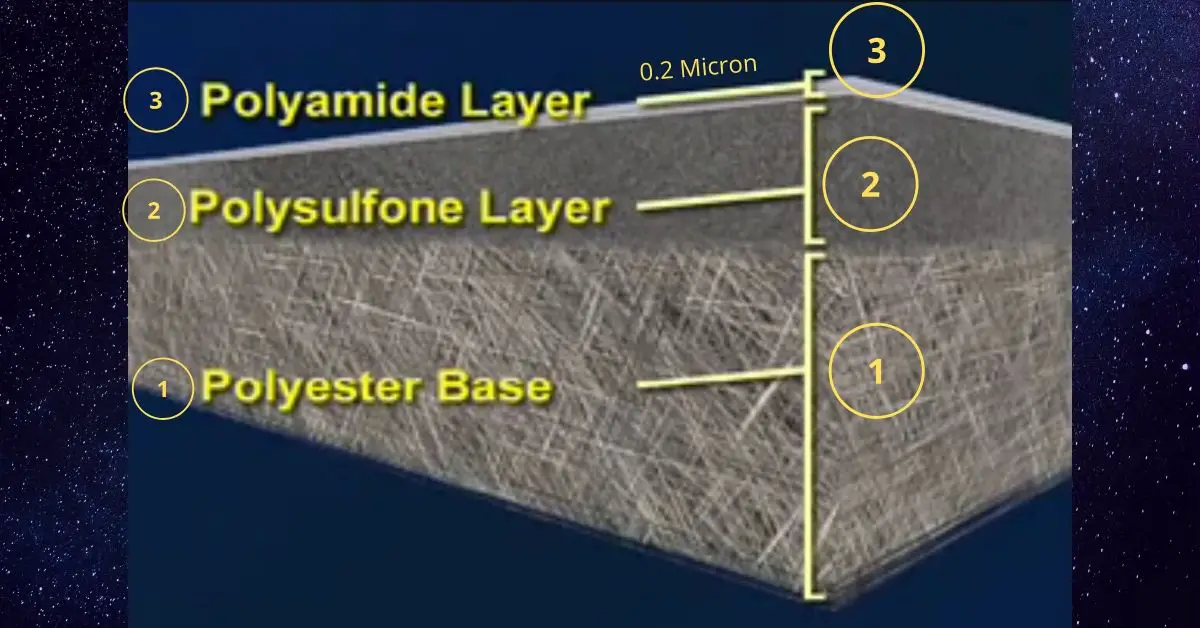RO membrane is the main component & heart of the any RO system. Best RO membrane works as a barrier for impurities present in water like dissolved salts,bacteria etc.
Do you know?
RO Membrane Types:
Reverse osmosis membrane are of two types:
- Cellulose Acitate (CA)Membrane: This membrane is chlorine tolerant & rejects 93% of containment present in water. It is not popular & not used in modern house hold reverse osmosis systems.
- Thin Film Composite(TFC) Membrane: It is also called as sheet membrane. It rejects 98% of containment present in water. This types of membranes are very popular & widely used in house hold as well as industrial reverse osmosis system.
In this section, we discuss the construction & working mechanism of about cellulose acetate TFC (Thin Film Composite) membrane in two simple steps.
1. Manufacturing Process of RO Membrane Flat Sheets
In this section, you’ll know how flat sheets of membranes are made.
Reverse Osmosis membrane constructed with automated casting equipment.It is made with flat sheets of membranes.
Let’s understand,
How membrane flat sheets are made?
The process starts by making first layer of polyester base & second layer of micro porous polysulfone.
This provides additional support for the third layer(membrane barrier layer) which is on the top & 0.2-micron thick.
This third barrier layer is responsible for the actual separation to purify the water.

The semi permeable polyamide layer (Third layer) consists of a thin film of polymeric material of few thousand angstroms thick formed on a porous supporting material.
A semi permeable membrane skin is formed on the poysulfone subtract by polymerization of monomers containing amine and carboxylic acid chloride functional groups.
Manufacturing procedure enables independent optimization of the distinct properties of the membrane to make salt rejecting skin.
The combination of these three layers makes a durable membrane flat sheet that is used in each “spiral wound” element.
In Conclusion, Thin film composite membrane consists three layers:
- Polyester support layer
- Microporous polysulfone interlayer
- Ultra-thin polyamide barrier layer on the top surface
Each layer is tailored to specific requirement. The pore size of the membrane is 0.0001 micron.
What is Semipermeable Membrane?
Semipermeable membrane is basically a very thin layer of polymeric material that acts as a barrier layer.
It separates dissolved ions or molecules from water when applied pressure is greater than osmotic pressure.
2. Spiral Wound Module Manufacturing &
RO Membrane Working Principle
In this section you’ll know,
how spiral wound reverse osmosis elements made from membrane flat sheets?
how does reverse osmosis membrane work?
The flat sheet of membrane is then combined with a sheet of feed channel spacer. This provides turbulence and creates space between the membrane sheets.
This allows uniform flow of the water to the entire membrane surface.
The leaves of membrane and feed channel spacer are then combined with a sheet of permeate spacer.
This provides open flow channels for the permeate water even under high pressure.
The leaves are glued along each of the three exposed sides and then roll around the core tube with the back of the membrane completely sealed to the edges of the permeate spacer.
The feed water is forced through the feed channel spacer contacting the front or barrier layer of the membrane.
Clean water or permeate passes through the membrane surface into the permeate channel and then flows in a spiral direction to the center of the element.
Finally, Clean water is collected into the core tube.
In the industrial RO System, more than one spiral wound element loaded into pressure vessels.
Pressure vessels interconnected with each other to complete any number of design specifications.
The end adapter connected to the last element and the pressure vessel is sealed & then feed water introduced.
Then, feed water that does not permeate through the membrane becomes concentrated & enriched in salts as it travels through the feed channel spacer.
The permeate water flows at the end of the vessel and is collected as the product.
The reject are concentrated from that vessel flows through another vessel and producing more permeate.
Finally, the remaining concentrate water or reject water disposed as waste. In some system reject water is also partially recycled to increase recovery rate.
Typically, 70% to 90% percent of the water can be recovered as pure product water.
Benefits of Thin Film Composite RO Membrane:
- Excellent performence in terms of flux,salt,organic rejection & micobiological resistence.
- It rejects 98% of contaminents
- Suitable for temperature up to 45 dEG C.
- Works in wide pH range between 2-11
- Shows resistance to short term attack by chlorine. The free chlorine tolerance of the membrane is <0.1 ppm
- The performance remains stable over several years even under harsh operating condition.
